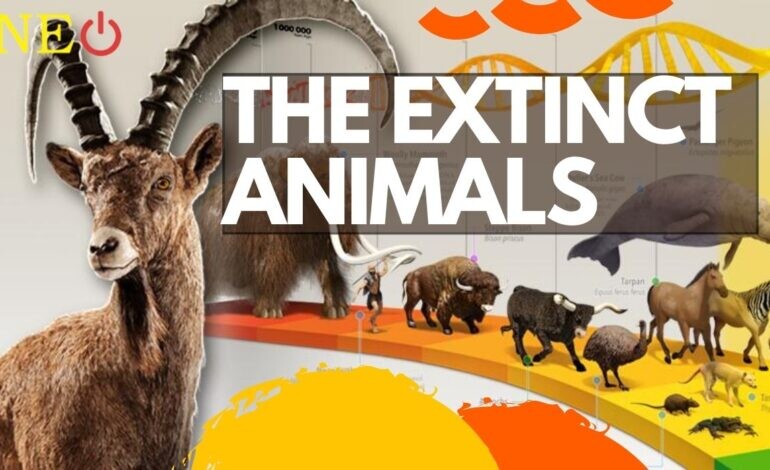World Environmental Health Day 2024
World Environment Health Day 2024 is on September 26, 2024, and recognizes the impact of environmental factors on human health.

Several species have been driven to extinction in the last few decades due, in major part, to human intervention. Sometimes the meddling is overt, like when someone steals an animal's tusks or big game trophy. And when it's indirect, such as with disruptive land development and the issue of climate change.
The good news is that there are steps we can take to slow the rate of extinction, such designating a place as a wildlife refuge or a species as "protected," or simply making a wildlife-friendly area in your own garden. Here is a collection of animals that have become extinct over the past 150 years.


The last two living northern white rhinos in existence happen to both be female as the last male died in March of 2018. Sudan, the 45-year-old male, was under armed guard at Kenya’s Ol Pejeta Conservancy when he passed away from old age and an infection.
The two females are also unable to give birth, making the likelihood of introducing a new generation of the species highly unlikely. Scientists are working on using harvested sex cells and in-vitro fertilization to bring forth a lab-created northern white rhino.
Poaching has decimated this population and loss of habitat also helped drive the rhino to the brink of extinction.


The smooth handfish, which was once common in the waters off Australia, is shown in the picture along with its near relative, the red handfish. The smooth handfish, which was declared extinct in 2020, was named for its striking similarity to human arms and hands. It also had a spike on its head that looked a lot like a punk-rock mohawk (just like its cousin shown here.) Only one preserved specimen of the extinct smooth handfish is now known to exist in the world.
Although the exact reason for its extinction is unknown, scientists believe that habitat loss and damaging fishing practises against other marine life, such as scallops, contributed to their demise.


The International Union for Conservation of Nature (IUCN) declared these small creatures extinct in 2015. The rodents, which are native to Bramble Cay, a small island near the northern portion of the Great Barrier Reef, have reportedly not been seen since way back in 2009. The Queensland state government stated that "significantly, this possibly represents the first reported animal extinction attributable to anthropogenic climate change."
Man-made climate change, which led to a loss of habitat and food.


The Yangtze River dolphin, also called "baiji," was last observed in 2002. Four years later, a team of scientists travelled 2,000 kilometres along the Yangtze River to look for one, but they were unsuccessful. The baiji dolphin is the first species of dolphin to go extinct as a result of humans, according to the Whale and Dolphin Conservation group (WDC).
Overfishing, pollution, habitat degradation, poaching, and boat traffic.


The Javan tiger, which originated on the Indonesian island of Java, shared similarities in appearance with the Sumatran tiger. They were so prevalent on the island in the 1800s that locals thought of them as pests, but as the island grew, their numbers decreased. There were only 20 tigers left by the 1950s.
Severe population reduction brought on by agricultural development and habitat loss. Due to inadequate acreage and planning, conservation initiatives in the 1940s and 1950s were unsuccessful.


When Charles Darwin visited the Galapagos Islands in 1835, the Pinta Island tortoise was present. Sadly, the only purebred of this subspecies, a male by the name of Lonesome George (shown), went away in 2015.
Humans introduced goats to Pinta Island, which ruined their habitats, along with rodents, who preyed on baby tortoises. Humans also killed the tortoises for their meat.


In honour of the German-born explorer Sir Robert H. Schomburgk, who was knighted in 1844, Schomburgk's deer was a native of Thailand.
Despite the fact that they were officially declared extinct in 2006 and the last known deer was apparently killed in captivity in 1938, some scientists think that there may still be a few of these deer in the wild.
Schomburgk's deer were hunted by local tigers and leopards in addition to people. We are now aware of just one mounted deer head, which is on display at the Muséum National d'Histoire Naturelle in Paris.


The Thylacine, a predator also known as the Tasmanian tiger and Tasmanian wolf, was a marsupial that was primarily active at night and fed on kangaroos and rodents.
Even though they had a fearsome appearance, thylacines were actually very timid and, according to Live Science, "could be taken without a fight." In the past century, reports of thylacine sightings have been so common that they have prompted a study into the status of their existence.
In addition to human overhunting, it is thought that Dingo populations posed a threat to the Thylacine's existence.


The Quagga was native to South Africa and went extinct in the late 19th century. For a long time, the quagga was thought to be its own species before it was discovered that it was closely related to the Plains Zebra and was, in fact, a subspecies of the zebra. Quaggas quite literally looked like a mashup between two animals—a zebra in the front thanks to set of characteristic stripes, and a horse in the rear.
Scientists are trying to resurrect the quagga and have seen some success via reverse engineering by selectively breeding zebras (who carry quagga genes).
Humans hunted the quagga to extinction.


Although not the only species to go extinct in the last 40 years, the golden toad may be the most noticeable.
Before being officially declared extinct in 1994, the little toad was last observed in a Costa Rican rainforest in 1989. Chytridiomycosis, a lethal skin condition, is thought to have devastated this toad population, which was already precarious due to what Science refers to as a "restricted environment and small population."
This species was wiped off as a result of chytrid skin diseases, global warming, and pollution.
World Environment Health Day 2024 is on September 26, 2024, and recognizes the impact of environmental factors on human health.

